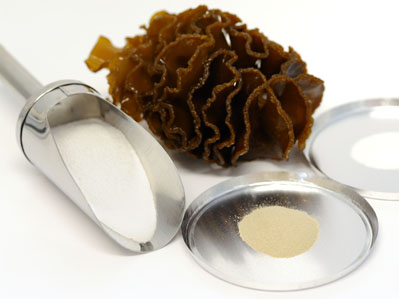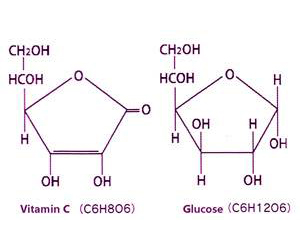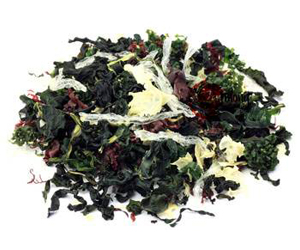Seaweed’s eternal life energy — fucoidan.
Noda et al. formed a research group concerned with antitumor properties of seaweed and conducted research on antitumor activity with respect to polysaccharides and lipids contained in many seaweeds. First, in order to discover antitumor activity in a variety of different seaweeds, they investigated 4 species of green algae, 24 species of brown algae, and 28 species of red algae. They transplanted solid Ehrlich tumors in mice that had been administered 14 days of these seaweed powders, administered them for another 14 days, and sought to determine tumor growth inhibition rates.

Unlike animals, which increase their genetic diversity through mating so their descendants can better adapt to the environment, seaweeds pass their genes unchanged. For example if a slice of mozuku seaweed (Latin name “Cladosiphon okamuranus”) tears off, that area becomes restored with exactly the same cells, and if the torn off slice takes root, cells with exactly the same genetic combinations as the base plant will begin to reproduce. In other words, seaweeds aim for eternity. Being constantly exposed to solar UV-radiation, rubbed by the tidal currents, eaten by fish, and lacking a thick bark, to stay alive, seaweeds were forced to develop a superior survival mechanism. Damaged cells in seaweeds need to be restored extremely quickly. One of the pivots of this restoration mechanism rests on fucoidan. Fucoidan lets seaweeds grow cells with unmutated genes only. One of the reasons fucoidan is considered potentially effective against cancers is due to its antiangiogenic (suppression of new blood vessel generation) action against cancer cells. Compared with the normal cells, cancerous cells are known to consume more glucose in order to reproduce. To sustain propagation, they will need more blood. Thus, they will work on the surrounding blood vessels and will start growing new blood vessels. Fucoidan restrains cancer from growing new blood vessels. That makes cancer cells starve and eventually trigger apoptosis (self-destruction). Normal cells in human organisms will contact surrounding cells, proliferate only where necessary, and after fulfilling their duty, will decompose naturally (through apoptosis). The cancerous cells will not self-destruct after fulfilling their biological duty but will continue their proliferation unabated. These cells repeat unlimited proliferation, metastasis, and infiltration into the neighboring areas. Cancer cells, unlike normal ones, produce energy through anaerobic metabolism, i.e., without using oxygen.
Energy production in cancerous cells is extremely inefficient.
If normal cells can produce 38 (including 2 from the glycolyptic pathways) ATP of energy from one molecule of glucose using aerobic metabolism, cancerous cells, which use anaerobic metabolism, can produce only 2 ATP. Why cancerous cells cannot perform aerobic metabolism just as the normal cells can remains a mystery. According to one theory, cancerous cells, which may occur because of an accumulation of genetic abnormalities, cannot control their mitochondria (a cell organelle), which have abnormalities in genes of their own. In other words, cancerous cells that used their mitochondria immediately after birth trigger apoptosis and self-destruct. Those that did not do so remain but cannot perform aerobic metabolism. Offending cancerous cells, which cannot use nutrients efficiently, interact with the surrounding cells and work to create an environment favorable for themselves. To consume more glucose, cancer cells affect normal blood vessels, melt their walls, and reconstruct the vascular network nearby. Fucoidan has an ability to restrain the vascularization of cancer cells, i.e., it suppresses their ability to grow new blood vessels.
Vitamin C fights cancer.

The chemical makeup of vitamin C is similar to that of glucose. Glucose is one of the typical simple sugars, and in an aqueous solution, it has a five-membered ring structure. Cancer cells need 20 times more glucose than the normal cells do. Cancer cells in which the vascularization ability was restricted with fucoidan do not obtain enough glucose and try to compensate for this with vitamin C. After getting inside a cell, vitamin C passes its electrons to the reactive oxygen and free radicals (which damage cells and tissues) and thus stabilizes them. Viceversa, vitamin C itself, looses electrons and similar to the reactive oxygen, gains oxidation properties and becomes the ascorbinic acid radical, which can damage cells. Normal cells have the catalase enzyme, which turns hydrogen peroxide into oxygen and water, so the normal cells remain protected. Unlike normal cells, cancer cells have their catalase activity lowered, so vitamin C in large amounts has the effect of killing cancer cells selectively. When the vitamin C blood level exceeds 350 mg/dl, this effect begins occurring on the condition that the glucose blood level is 120 mg/dl. As such, cancer cells can obtain only one-fourth of the glucose they need. In the cancer treatment method called the “up and under method,” which combines a high concentration vitamin C intravenous drip injection method and fucoidan treatment method, fucoidan serves to restrain cancer from growing new blood vessels, after which cancer cells become malnourished and start taking in more vitamin C, which damages them.

When malnutrition becomes worse, cancer cells are forced to use aerobic energy production but are unable to control their mitochondria, so eventually these cancer cells trigger apoptosis and die. This treatment method has no side-effects, and it also helps energize the normal cells, which helps persons weakened by chemotherapy and the like revitalize. This method was implemented in the Asahi Clinic (Shiga prefecture, Japan) by Dr. Kazuhide Miura.
About Dr. Kazuhide Miura
Dr. Kazuhide Miura is the director of Asahi Clinic and a secretary of the Japan Holistic Medicine Association in Fukuoka. After graduating from Kurume University in 1988 in Fukuoka Prefecture, Japan, he began working in the Child Surgery/First Surgery and Anesthesiology Department in the hospital at the same university. In 1995, he earned a Ph D in medicine for research conducted on the metastasis system of large intestine cancer. He is a certified physician of the Japan Surgical Society, a certified anesthesiologist, a member of the Japan Anti-aging Society, and head of the Holistic Science Forum.


1 thoughts on “Fucoidan and vitamin C in the fight against cancer”
Comments are closed.